
One of the most cruel murderers in Russian criminal history was Andrei Romanovich Chikatilo, better known as “the Monster or the Ripper of Rostov.” This Russian serial killer murdered at least 53 people between 1978 and 1990 in Rostov, Moscow, St. Petersburg, Yekaterinburg, Uzbekistan, and Ukraine before he was executed by a shot to the neck on February 14, 1994. But who was this monster who, according to his own statements, had slaughtered as many as 56 people? Andrei was born on October 16, 1936, in the small village of Yabluchne in the Ukrainian SSR. At that time, the population was still suffering from the famine of recent years, which had led to cannibalism among the population. According to his mother, his brother had also fallen victim to this, having been kidnapped and eaten by the hungry population. Andrei’s childhood was marked not only by his mother’s beatings, but also by World War II. Bombings, rapes, and shootings were part of his everyday life, which is why he wet his bed until he was 12 years old. Andrei was a good student who was bullied by the other children because of his severe visual impairment and physical weakness. As a teenager, he realized that he had chronic erectile dysfunction. This caused him to have low self-esteem and feel like a man without genitals or eyes. Since his father had been convicted of desertion and spent years in a labor camp, he constantly tried to shake off the image of being the son of a traitor to his country by becoming a model citizen of the Soviet Union. He went to Nizhny Tagil in the Urals for two years, where he worked on large construction sites and attended lectures in engineering. He was a passionate writer of patriotic articles for newspapers, joined the Communist Party of the Soviet Union, and worked as an informant for the police. After his military service, which he spent partly as a communications technician in Berlin, Andrei returned to his home village. There he began a relationship with a divorced woman. Word of Andrei’s erection problems quickly spread throughout the village, prompting him to attempt suicide, but he was saved. After his failed suicide attempt, he moved to the outskirts of Rostov-on-Don and worked as a communications technician. In 1963, he married Feodosija, a friend of his sister’s. They lived together like brother and sister, but had two children. To do this, Andrei had to masturbate. His wife then inseminated herself manually. In 1965, he began studying Russian literature and language at the Russian University of Rostov alongside his work. He successfully completed his studies in 1970. In the same year, he got a job as a Russian and sports teacher. However, due to his lack of authority, he was bullied by his students, which is why he had to change jobs several times until, in 1973, he indecently touched a 15-year-old student on her breasts and genitals during swimming lessons. When further sexual assaults on students came to light, he was suspended from teaching. In 1978, he moved to Shakhty, where he worked as a teacher at a mining school. But there, too, he sexually abused boys and girls, which cost him his job. Since then, he has worked as a warehouse manager in a locomotive factory in Rostov. This job involved a lot of business trips that took him all over the Soviet Union. He settled in Shakhty, where he bought a dilapidated cottage in September 1978, in which he also committed his first murder on December 22, 1978, of 9-year-old Yelena Sakotnova, whom he had met by chance on his way home. He lured her into his dacha to abuse her. But he couldn’t get an erection, so he stabbed her repeatedly in the abdomen with a folding knife he had bought beforehand until she was dead. He then ejaculated on her corpse before dressing her again and throwing her into a river. Her body was found two days later. Andrei quickly came under the scrutiny of investigators, but was released because the sperm on the body indicated that the perpetrator had blood type A. Andrei, however, had blood type AB. This also saved him in 1984 when he was again suspected of murder. What no one considered at the time was the fact that Andrei was a so-called biological special case. This is because in 20 percent of people, the blood group antigens in body fluids such as sperm do not match. This initially saved Andrei, and so an innocent man, Ukrainian Alexander Kravchenko, was executed on March 23, 1982, for the murder of Yelena Sakotnova. This was because he had already been in prison for raping and murdering a girl of the same age, and blood spatters matching Yelena’s blood type were found on his clothes during a search of his apartment. Unfortunately, his wife had the same blood type and also testified that her husband was at home at the time of the crime. But the police needed a murderer, so Kravchenko was tortured into confessing, which cost him his life. Meanwhile, Andrei continued to murder. He always followed the same pattern. He lured young men and women into wooded areas, where he tried to rape them. Since he couldn’t get an erection, he mutilated his victims by gouging out their eyes, cutting off their genitals, or slashing their stomachs. This was the only way he could achieve orgasm. He often ate his victims’ genitals afterwards, either raw or cooked over a fire in the forest. Andrei was a sadistic psychopath with necrophilic tendencies and an extreme penchant for cannibalism. He felt no compassion for his victims. In total, the monster of Rostov was hunted for 12 long years by 127 criminal investigators, a special brigade from the Moscow public prosecutor’s office, and hundreds of informants and decoys until they were finally able to arrest him on November 20, 1990. But since no police officer could get Andrei to talk, psychiatrist Alexander Buchanowski was entrusted with the task, as time was running out. According to Soviet law, a suspect could only be held for 10 days if no charges had been brought against him. Buchanowski managed to build a relationship of trust with Andrei through conversations, and on the last day of the deadline, Andrei confessed to a murder. Now charges could be brought against Andrei. In April 1992, the trial of Andrei began, who was proven guilty of 53 murders. He was therefore sentenced to death by firing squad on October 14, 1992. This sentence was carried out on February 14, 1994, with a shot to the back of the head. With that, the monster of Rostov was finally history.




